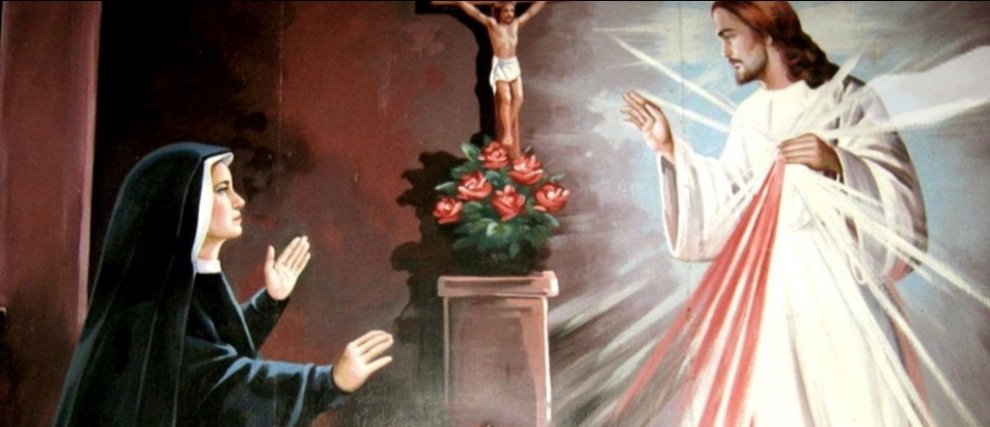The Painting of Merciful Jesus
The First Painting of Merciful Jesus
The first painting, called the Vilnius painting, was painted in that city in 1934 by Eugene Kazimirowski (1893-1939).
Origin of the painting
On February 22, 1931, Jesus appeared to Sister Faustina and asked her to have a painting of him done. The young nun was first blocked by the misunderstandings of her superiors, until she met Father Michel Sopocko in Vilnius (Lithuania). Sister Faustine was sent as a gardener to the Sisters of the Visitation in 1933.
It was this priest, chaplain of the convent and confessor of Sister Faustine, who found the painter to make the painting.
Eugene Kazimirowski, a neighbor of Father Sopocko, was a Polish student. Saint Faustina met him for the first time on January 2nd, 1934, at the feast of the Most Holy Name of Jesus. For about six months, she went every week to see the painter to give him advice and corrections concerning the painting.
Description of the painting
The painting responds precisely to Jesus' request, since it appeared as he wanted to be painted.
Christ explained the meaning of every detail to Saint Faustina. His position indicates that He is coming to the one who is looking at the painting. The most intense light comes from the heart, the light on the forehead indicates the presence of the Father. His right hand is blessed, and his left hand has an open heart from which two rays of light emerge. “These two rays indicate blood and water: the pale ray means water, which justifies souls; the red ray means blood, which is the life of souls. These two rays gushed from the bowels of my mercy, while my Heart, dying on the Cross, was opened by the spear. (…) Blessed is he who lives in their shadow” (D 299).
Jesus looks down. Christ explains: “My gaze on this image is the same as that which I had on the cross” (D 326)
The painting would always disappoint Sister Faustina, who said to Jesus, “Who will paint you as beautiful as you are? Then she heard these words: “It is not in the beauty of the colurs, nor in that of the brushstroke, that the greatness of this painting resides, but in my grace” (D 313).
The inscription Jesus I trust in You is an essential element of the painting, and Jesus never ceased to remind Faustina of its importance. Indeed, trust is the attitude that Jesus expects when he pours the treasures of his mercy into the heart of every man.
History of the painting
The painting was first exposed to public worship thanks to Blessed Michel Sopocko from 26 to 28 April 1935. This took place in the Chapel of Our Lady of Mercy in the presence of Sister Faustina. She was very pleased to see the Lord's requests fulfilled in this way. Especially since Father Sopocko gave a sermon on Divine Mercy, the first that Jesus had demanded for a long time. She testifies to this event: “For three days this painting was placed in plain view and received public honors because it was placed at the Gate of Dawn, at the top of the canopy, which is why it could be seen from very far away. At the Gate of Dawn, the closing of the Jubilee of the Redemption of the World, 1900 years after the Savior's passion, was solemnly celebrated during these three days.”
During the Soviet era, the painting was hidden in Belarus (from 1956 to 1986). In 2005, after being restored, it was placed in the Trinity Church of Vilnius, where it is today.
Jesus' Words Concerning the Painting
In her Diary, Faustina recounts these promises of Christ: “I promise that the soul who honors this painting will not be lost. I also promise him victory over his enemies here on earth, especially at the hour of death. I myself will defend it, as my own glory “(Defend it as my own glory ”(D 47).
Jesus says again: “By this image I will give many graces; so let every soul have access to it” (D 570).
Jesus has this image: “I give men a vessel, with which they must come to draw grace from the source of mercy. This vase is this painting, with the inscription: “Jesus, I trust in You”.
The Second Painting of Merciful Jesus
The second picture is now known worldwide. It was made in 1943 in Krakow-Lagiewniki by Adolphe Hyla. He painted it as an ex-voto to offer it to the sisters of Our Lady of Mercy. He wanted to thank the Lord for sparing his family during the Second World War. He followed the model of the first painting while giving free rein to his inspiration.
The painting was placed in the Sacred Heart Church in Wrocław. The painter had to produce a second painting identical to the right dimensions. It is the one that is today in the chapel of the Sisters of Our Lady of Mercy in Krakow where the relics of Saint Faustina are venerated.
There are also other paintings of merciful Jesus, all made according to the model of the first painting.
The spread of St Faustina's message, the increasingly widespread reading of her writings and the actions carried out throughout the world to make known the message of Divine Mercy have given the picture the global influence it has today.
The painting of the merciful Jesus is one of the five main means given by Jesus to Saint Faustina to enter into his mercy and receive its graces. There are also in these means several devotions such as the rosary of mercy, the novena to the Divine Mercy, the hour of mercy and the Feast of Mercy.
